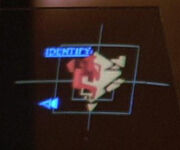No edit summary |
m (Robot: Automated text replacement (-==Background== +== Background information ==)) Tag: apiedit |
||
| (17 intermediate revisions by 12 users not shown) | |||
| Line 1: | Line 1: | ||
| − | [[ |
+ | [[File:Klingon mummification glyph.jpg|thumb|A Klingon mummification glyph]] |
| − | A '''Klingon mummification glyph''' |
+ | A '''Klingon mummification glyph''' was a form of carved pictograph writing used by the [[Klingon]]s. |
| − | During [[Spock]]'s [[memory test]] in [[2286]], he was asked to identify a particular |
+ | During [[Spock]]'s [[memory test]] in [[2286]], he was asked to identify a particular symbol, which turned out to be a mummification glyph. ({{film|4}}) |
| + | == Background information == |
||
| − | : ''This reference seems to indicate that Klingons valued the bodies of their dead at one point, which contradicts the line stated by [[Korris]] and [[K'Nera]], in "[[Heart of Glory]]" ([[TNG]]); after death, the Klingon body is but an 'empty shell'.'' |
||
| + | The Klingon mummification glyph seen in the fourth movie was identified in the script as coming from the earliest part of the [[Zanxthkolt Dynasty]]. The movie was not so specific. |
||
| + | |||
| + | The practice of mummification would seem to indicate that Klingons valued the bodies of their dead at some point, in contradiction to the episode {{e|Heart of Glory}}; where the Klingon body was considered a 'empty shell' immediately upon death. It should be noted that this idea was also seemingly contradicted by the practice of ''[[ak'voh]]''. However like it 'ak'voh'' it could represent an ancient and antiquated position that is no longer commonly observed, it might also be possible that only the remains of certain important individuals were preserved. At least the ancient ruler [[Molor]] might in fact have been mummified, since some entrepreneurs on [[Maranga IV]] claimed to have Molor's mummified head on display for a fee of 50 [[darsek]]s per person. ({{TNG|Firstborn}}) |
||
| − | Some entrepreneurs on [[Maranga IV]] claim to have [[Molor]]'s mummified head on display for a fee of 50 [[darsek]]s per person. ([[TNG]]: "[[Firstborn]]") |
||
[[Category:Qo'noS]] |
[[Category:Qo'noS]] |
||
| + | [[Category:Culture]] |
||
Revision as of 12:29, 24 October 2015

A Klingon mummification glyph
A Klingon mummification glyph was a form of carved pictograph writing used by the Klingons.
During Spock's memory test in 2286, he was asked to identify a particular symbol, which turned out to be a mummification glyph. (Star Trek IV: The Voyage Home)
Background information
The Klingon mummification glyph seen in the fourth movie was identified in the script as coming from the earliest part of the Zanxthkolt Dynasty. The movie was not so specific.
The practice of mummification would seem to indicate that Klingons valued the bodies of their dead at some point, in contradiction to the episode "Heart of Glory"; where the Klingon body was considered a 'empty shell' immediately upon death. It should be noted that this idea was also seemingly contradicted by the practice of ak'voh. However like it 'ak'voh it could represent an ancient and antiquated position that is no longer commonly observed, it might also be possible that only the remains of certain important individuals were preserved. At least the ancient ruler Molor might in fact have been mummified, since some entrepreneurs on Maranga IV claimed to have Molor's mummified head on display for a fee of 50 darseks per person. (TNG: "Firstborn")
